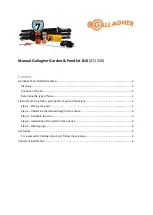
Surge Test Applications
12/3/2009 | 71-022 V6
D30R
52
32)
For capacitor-started motors or systems with surge arrestors/power factor
capacitors, be sure to
disconnect
all capacitors from the test circuit
before
testing.
33)
Upon completion of a DC High Potential, Megohm, Polarization Index, Step Voltage,
Dielectric absorption, or Continuous Ramp test, before disconnecting the test leads,
short the winding, motor, etc., to ground and allow time for discharge. If this is not
done, voltage may still be active on leads and tested components.
34)
Make sure
the tester leads are disconnected before the motor is energized or
powered up.
35)
Do not
remove the product covers or panels or operate the tester without the
covers and panels properly installed. Components on inside of tester carry voltage
for operation and if touched can render a shock.
36)
Use appropriate safety equipment required by your organization, including high
voltage globes and eye protection.
37)
Repair Parts Warning
: Defective, damaged, or broken test leads must be replaced
with factory-authorized parts to ensure safe operation and maintain performance
specifications.
38)
Ground the product:
This product is grounded through the grounding conductor of
the power cord. To avoid electrical shock, plug the power cord into a properly
wired/grounded receptacle before connecting the product test leads.
Danger from loss of ground – Upon loss of the protective ground connection,
all accessible conductive parts, including knobs and controls that may appear
to be insulated, can cause an electric shock!
39)
This instrument is
NOT
waterproof or sealed against water entry.
40)
The unit is for indoor use. If used outdoors, the unit must be protected from rain,
snow and other contaminants.
Maintenance testing
The following are guidelines for performing surge tests on a variety of assembled motors,
coils, transformers, rotors, etc in the field or shop as part of maintenance and quality testing.
Hard-shorted winding faults are rarely found in motors during maintenance testing. Solid
turn-to-turn winding faults happen when the insulation on adjacent copper wires has failed to
the point that the adjacent wires are welded together. It is a rare for periodic maintenance
testing because of a transformer action which occurs within the windings which induces very
high current in a hard turn-to-turn short. The high current causes heating and deterioration
of the surrounding insulation systems. The single turn-to-turn short rapidly compounds until
the damage causes a failure in the ground wall insulation. The high current will trip the circuit
breaker and stop the motor. This condition is usually only found after the motor has failed.
The key to the surge test for maintenance is to detect a fault at a voltage level above the peak
operating voltage but not above what the motor would general see during start-up. For
example, a 13200 V motor that shows a good trace at 14250 V but shows an unstable,
flickering patter, (regardless of rotor coupling) at 24000 V definitely contains a fault. When
the fault is detected above operating voltage, time is available to schedule service for the
motor before a hard short and rapid failure occurs.
During surge testing, steady separation in the wave pattern comparisons is most often the
result of the rotor coupling with the stator. (See Rotor Loading (Coupling) when testing
Содержание D30R
Страница 6: ...Table of Contents 12 3 2009 71 022 V6 D30R 6...
Страница 12: ...Safety precautions CE compliance 12 3 2009 71 022 V6 D30R 12...
Страница 24: ...Coil Resistance Testing 12 3 2009 71 022 V6 D30R 24...
Страница 28: ...Principles of High Voltage DC Testing 12 3 2009 71 022 V6 D30R 28...
Страница 38: ...High Voltage DC Testing 12 3 2009 71 022 V6 D30R 38...
Страница 50: ...Surge Testing 12 3 2009 71 022 V6 D30R 50...
Страница 70: ...Data Recording Retrieving 12 3 2009 71 022 V6 D30R 70...
















































